One of the questions I regularly get asked by runners wanting to go off-road into trail running is about kit. There is something of a disparity about the kit that people have in mind to the stuff I’d recommend people carry, so I thought I’d do a post now that the spring is upon us and the UK national lockdown is gradually beginning to ease.
What you need to consider is that when running off-road you need to be much more self sufficient compared to running along the road where there’s usually a shop close to hand if needed, but certainly it’s a lot more accessible if you need to get picked up if you decide (or need) to end your run early. The conditions when you’re out in the hills can also be different to those at home so it’s important to be prepared for this.
Training runs are not only good for getting fit for that event that you are working towards, but also to test out the kit you’re planning to take, including nutrition. Here’s a few things to think about.
Trail Running Shoes AND socks
Road shoes are NOT appropriate for most of the runs we do. Trail and Fell Running Shoes have a lot more grip on the sole compared to Road Running Shoes. Whilst tarmac is even and predictable, once you are running off road you can and will encounter many different conditions be it stony trails, muddy paths, grassy hills. Having the appropriate footwear is really important to reduce the risk of trips and slips.

Look at the difference in gripping lugs on the fell shoe on the left compared to the road shoe
Socks are one of the most neglected parts of kit. You should consider purchasing a sock that is suited to the terrain you are running on, and in our case a wool sock is much better than a thin road sock. There are also waterproof socks but bear in mind that water that does get in, stays in and you end up with a heavy, soggy sock. Also, bear in mind that wool will have an extra thickness and therefore your shoes will feel tighter than normal and so you might struggle if your shoes are already a tight fit. Consider going up half a size in trail/fell running shoes, maybe even a full size.
Waterproof outer-layer (with TAPED SEAMS)
The weather can be quite different when on the hills compared to lower ground and can change quickly and unexpectedly. We would always recommend carrying a lightweight waterproof jacket. Waterproof trousers should also be carried. These items are designed to pack down small and can be kept in your running pack just in case. Not only are they good protection against wet weather, but they are also useful to help stay warm should you find yourself outdoors for longer than you had planned e.g. if you need to wait for medical assistance. It is always recommend that you check the weather forecast for where you are running before you set out so that you can be prepared. The weather can change quickly and the forecast you saw the night before may have been updated since.
- Waterproof jackets don’t have to be bulky
- My waterproof jacket is lightweight and packs down really small
- waterproof trousers with taped seems can be lightweight and back small so they’re there if you need them.
Hat, Gloves & “Buff” / snood
These items give you additional warmth and protection in colder weather. Additionally, headwear in the summer can offer some protection against the sun. A lightweight item such as a buff/snood can be used in many different ways although is not as warm as a woolly hat in winter. Again these items are light/small and easily tucked into a pocket in your bag. Don’t just think a buff/snood will be a substitute for a woolly hat. If you’re going somewhere exposed you’ll be thankful for the extra warmth.
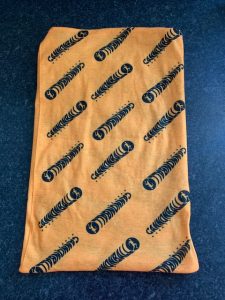
A “buff” / snood can be used in many differnt ways
Food & hydration
It is recommend you carry some food and water with you, even if it is just an energy bar or gel. In the event of an emergency or if you are out for longer than planned, having these extra calories and fluids can be essential for keeping you fuelled for the remainder of your run. There are many different options for food and it’s very individual what works for you. If you’re out for a long period of time it’s worth having a mix of sweet and savoury; there’s nothing worse than carrying a load of food that you can’t face eating.
It’s always worth having a soft-flask of water with you too. Depending on the intended length of your run adding electrolytes to the water can be beneficial to ensure your body can continue to absorb the fuel and hydration. Again exactly what you use is a matter of personal preference.
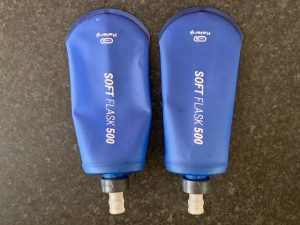
Soft flasks are lightweight and easy to carry and use
Mobile phone
Whilst it’s worth noting that mobile reception can often be patchy when up in the hills, it’s sensible to always carry your mobile phone with you. At least with it there’s a chance of being able to make a call, compared to not having your phone with you. I would always suggest that you consider your mobile as a backup/safety device though, rather than something you intend to rely on. Relying on technology for your navigation is not to be recommended because if you can’t get a signal or the battery gives up you’re left with a dead phone and no idea where you are!
A couple of free apps worth downloading to your phone;
• OS Locate will provide you with your OS Map grid reference;
• What3Words is a geocode system which pinpoints your position to within a 3 metre square. In an emergency this information can be provided to the emergency services to pinpoint your location.
By having these apps downloaded to your phone before you head out on your run, should you need to get assistance from the emergency services, the location information from these apps will help to pinpoint your exact location.
If you are going out on your own, I would recommend you let someone know where you are going running and when you’re expecting to be home, just in case there is a problem. And obviously let them know when you are safely home so they don’t worry.
First aid and other health considerations
You should always carry a small first aid kit. This should include some plasters, safety pins, and bandages. This is not an exhaustive list and you should also remember the time of year, so sun cream and Vaseline will need to be packed or applied before your run.
Headtorch
If you are out running off-road at night you will need to get a head torch. There are generally no streetlights once you are away from the town so having a head torch means you will be able to see where you are running. Don’t skimp on a headtorch – you will need to spend £40+ to get one that is effective. It’s worth packing your head torch even if you’re not planning on running at night. If you get delayed when out in the hills and the light starts to fade, you’ll be glad it’s there.
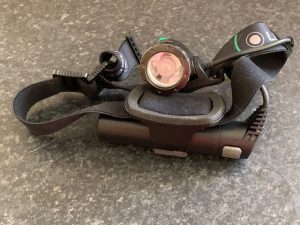
Spend a little more on a headtorch to get one that’s up to the task
Map, Compass & Whistle
If you are out on your own away from town, we would recommend carrying a map and compass. Whilst your mobile phone may be helpful in showing where you are on a map, it relies on battery power which may run out if you are out for a long period of time so shouldn’t be relied upon for navigation. If you subscribe to the OS Maps service, you can print off the sections of maps covering the area that you’re running if you don’t already have the paper map of the area.

Having a map that’s waterproof can be helpful in the UK!
As an aside, make sure you don’t store your mobile phone next to your compass. The magnetic field from the phone can sometimes cause the compass to flip! Here’s an article where this led to a group of walkers needing to be rescued.
Additional clothing
Normally whilst we are running, we keep warm, but if you needed to stop e.g. if you turned your ankle and needed to wait for help to get home, you can get cold very quickly. Therefore, having an extra layer in your bag can be useful in case of such situations. This is an interesting experiment conducted by a couple of running coaches in Scotland to demonstrate this fact.
At the very least having your lightweight waterproofs, hat and gloves will help in an emergency but they may not be enough. Carrying lightweight additional layers can help to keep you safe and warm just in case of an emergency.
Carrying your kit AND keeping it dry
Getting hold of a small running backpack will make it easy to carry all of the above items. They aren’t heavy and often have features such as pockets for hydration flasks, food and easy access to your kit. Some packs even come with a built in whistle to help attract attention if you needed assistance. You should invest in waterproof small bags to keep your phone and kit dry. Most running backpacks themselves are not waterproof (although they will offer a bit of weather protection).
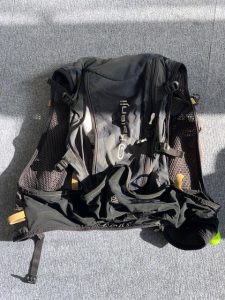
having a running pack that stores everything whilst providing easy access to essential kit is really useful.
I’ve included a bit of the kit I carry for information in this post but it’s something that is rarely static depending on where I’m running, how long I’m planning to be out and what time of year it is. My actually kit list isn’t exhaustive and changes all the time, but hopefully this give you an idea of what to think about. Much of my kit is relatively inexpensive but ultimately it has to be fit for purpose. There’s no point in cheaping out then finding your coat isn’t waterproof or your head torch couldn’t light up the under-stairs cupboard. Nor is there much use in buying the kit and leaving it at home!
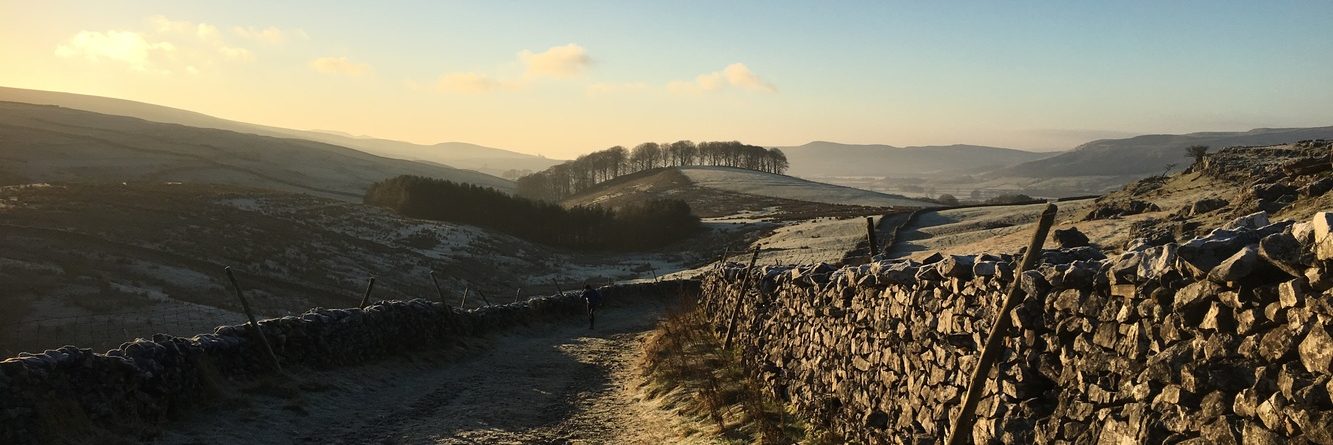
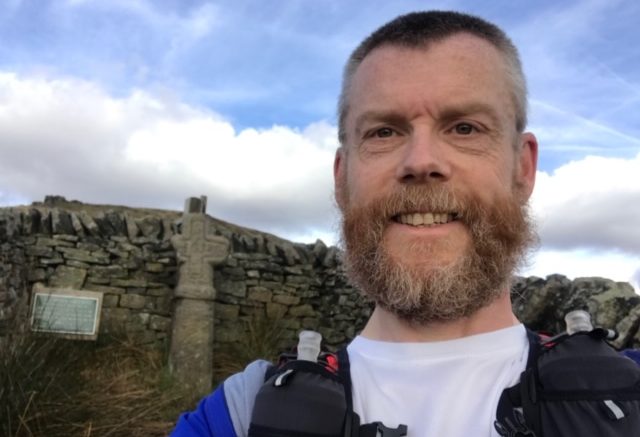

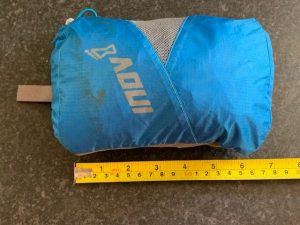

Be the first to comment on "Trail running kit"